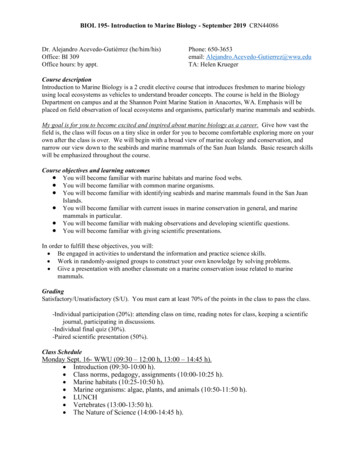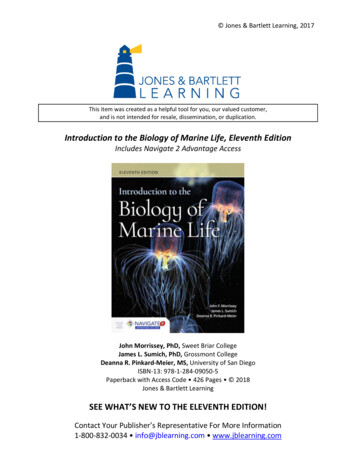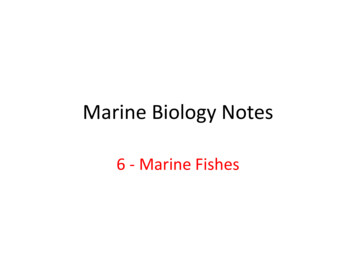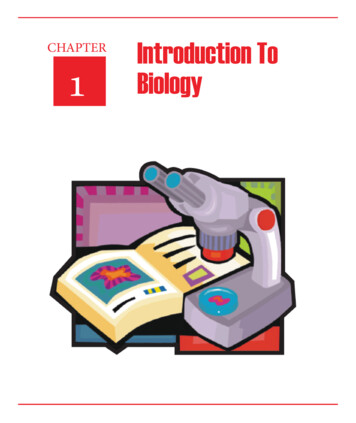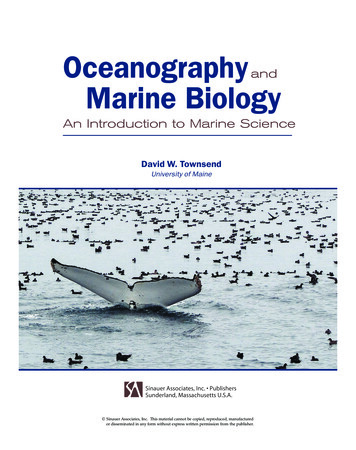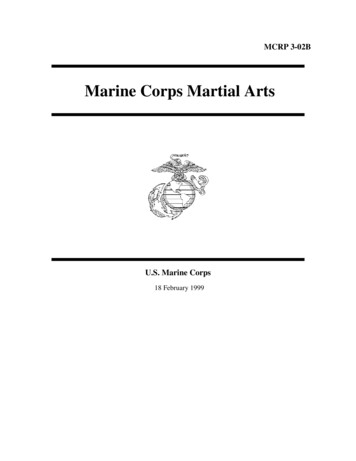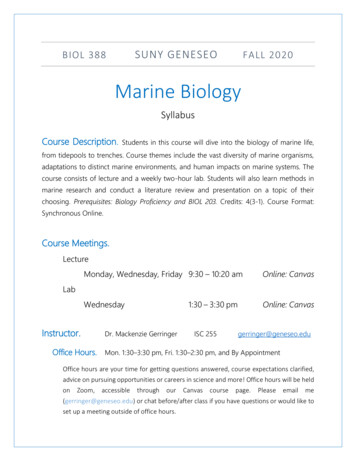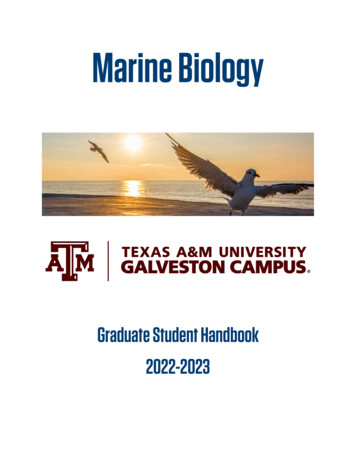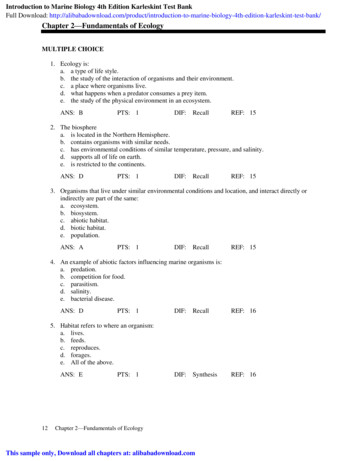
Transcription
Introduction to Marine Biology 4th Edition Karleskint Test BankFull Download: hapter 2—Fundamentals of EcologyMULTIPLE CHOICE1. Ecology is:a. a type of life style.b. the study of the interaction of organisms and their environment.c. a place where organisms live.d. what happens when a predator consumes a prey item.e. the study of the physical environment in an ecosystem.ANS: BPTS: 1DIF: RecallREF: 152. The biospherea. is located in the Northern Hemisphere.b. contains organisms with similar needs.c. has environmental conditions of similar temperature, pressure, and salinity.d. supports all of life on earth.e. is restricted to the continents.ANS: DPTS: 1DIF: RecallREF: 153. Organisms that live under similar environmental conditions and location, and interact directly orindirectly are part of the same:a. ecosystem.b. biosystem.c. abiotic habitat.d. biotic habitat.e. population.ANS: APTS: 1DIF: RecallREF: 154. An example of abiotic factors influencing marine organisms is:a. predation.b. competition for food.c. parasitism.d. salinity.e. bacterial disease.ANS: DPTS: 1DIF: RecallREF: 16DIF: SynthesisREF: 165. Habitat refers to where an organism:a. lives.b. feeds.c. reproduces.d. forages.e. All of the above.ANS: E12PTS: 1Chapter 2—Fundamentals of EcologyThis sample only, Download all chapters at: alibabadownload.com
6. The habitat of a species hasa. both abiotic and biotic factors.b. neither biotic or abiotic factors.c. biotic factors.d. abiotic factors.ANS: APTS: 1DIF: RecallREF: 16DIF: RecallREF: 167. Habitat complexity can supporta. complex life histories.b. increased biodiversity.c. higher productivity.d. more different species in an area.e. All of the above.ANS: EPTS: 18. An environment would be considered harsh to an organism if:a. it would be difficult for the individual to maintain homeostasis.b. the temperatures are extreme.c. salinity varies.d. pressure gradients are large.e. light levels are low.ANS: APTS: 1DIF: RecallREF: 169. Regions above or below the optimal range of an environmental variable are called:a. zones of stress.b. tolerance zones.c. optimal range areas.d. None of the above.e. b and c only.ANS: APTS: 1DIF: RecallREF: 1710. A population growth pattern that reaches a certain level is described with a(n)a. logarithmic equation.b. exponential equation.c. logistic equation.d. J -shaped curve.e. quadratic equation.ANS: CPTS: 1DIF: RecallREF: 2411. You start to culture a petri dish of marine bacteria. Each day, the number of visible colonies growingon the agar surface increases in this fashion: 2, 4, 16, 32, 64, 128. This growth pattern is best describedasa. logarithmic.b. logistic.c. exponential.d. quadratic.ANS: C13PTS: 1Chapter 2—Fundamentals of EcologyDIF: ApplicationREF: 24
12. The largest group and most important marine photosynthetic organisms are:a. kelp.b. seagrasses.c. macroalgae.d. phytoplankton.e. giant kelps.ANS: DPTS: 1DIF: RecallREF: 1713. Animals that obtain their body heat from internal metabolism are called:a. ectotherms.b. poikilotherms.c. endotherms.d. osmoconformers.e. osmoregulators.ANS: CPTS: 1DIF: RecallREF: 1814. An organism that maintains a constant body temperature is termed:a. an endotherm.b. an ectotherm.c. a poikiotherm.d. cold blooded.e. an osmoconformer.ANS: APTS: 1DIF: RecallREF: 1815. An organism whose temperature is similar to its surroundings is called a(n)a. endotherm.b. poikiotherm.c. ectotherm.d. warm blooded organism.e. osmoregulator.ANS: CPTS: 1DIF: RecallREF: 1816. A particular sea bird has a Type 1 survival curve, and older female birds produce more eggs thanyounger birds. What is an evolutionary strategy of these birds?a. young birds reach maturity rapidlyb. reproduction is delayedc. birds reach maturity slowlyd. both a and be. both b and cANS: EPTS: 1DIF: ApplicationREF: 22–2317. The amount of dissolved salts in water determines the:a. temperature.b. luminosity.c. salinity.d. clarity.e. turbidity.ANS: C14PTS: 1Chapter 2—Fundamentals of EcologyDIF: RecallREF: 18
18. The movement of water across a membrane in response to a gradient of solute concentration is called:a. salinity.b. osmosis.c. solubility.d. diffusion.e. pressure.ANS: BPTS: 1DIF: RecallREF: 1819. An atmosphere of pressure at sea level,, in psi (pounds per square inch), equals:a. 15.b. 14.7.c. 15.7d. 16.5.e. 16.7ANS: BPTS: 1DIF: RecallREF: 1920. The pressure of the oceans increases by one atmosphere for every meter increase in depth.a. 5b. 10c. 15d. 20e. 25ANS: BPTS: 1DIF: RecallREF: 1921. At what depth would water pressure be 4 times greater than atmospheric pressure at the surface?a. 10 metersb. 20 metersc. 30 metersd. 40 meterse. 50 metersANS: DPTS: 1DIF: ApplicationREF: 1922. In the carbon cycle, animals play a fundamental role by:a. decreasing the amount of dissolved carbon dioxide.b. increasing the amount of dissolved carbon dioxide as a result of respiration.c. increasing the amount of dissolved carbon dioxide as a result of photosynthesis.d. decreasing the amount of plant biomass.e. decreasing it as a result of photosynthesis.ANS: BPTS: 1DIF: RecallREF: 3623. An important inorganic nutrient needed by marine photosynthetic organisms is:a. glucose.b. amino acids.c. lipids.d. nitrates.e. carbohydrates.ANS: D15PTS: 1Chapter 2—Fundamentals of EcologyDIF: RecallREF: 36
24. Oxygen during the early development of the atmosphere was:a. common.b. rare.c. important for photosynthesis.d. about the same as now.e. created from the cooling of hot lava.ANS: BPTS: 1DIF: RecallREF: 2025. Those organisms that thrive in an environment free of oxygen are calleda. phytoplankton.b. zooplankton.c. nekton.d. anaerobes.e. aerobic.ANS: DPTS: 1DIF: RecallREF: 20DIF: RecallREF: 20DIF: RecallREF: 2026. Anaerobic organisms thrive:a. in oxygen-free environments.b. where oxygen is abundant.c. where carbon dioxide is abundant.d. in surface waters of the ocean.e. in the middle of the water column.ANS: APTS: 127. Metabolic wastes are:a. the byproduct of metabolism.b. unused nutrients during metabolism.c. re-used by the organism.d. unimportant to community metabolism.ANS: APTS: 128. Waste products of metabolism tend to accumulate in:a. open ocean areas.b. coastal waters.c. small enclosed bodies of water.d. fast circulating water.e. major ocean currents.ANS: CPTS: 1DIF: RecallREF: 2029. When two different species require the same resources we may observea. intraspecific competition.b. resource partitioning.c. interspecific competition.d. predation.e. symbiosis/parasitism.ANS: C16PTS: 1Chapter 2—Fundamentals of EcologyDIF: RecallREF: 20
30. is when one organism successfully outcompetes another organism and excludes it from aparticular area or niche.a. Predationb. Resource partitioningc. Parasitismd. Competitive exclusione. CommensalismANS: DPTS: 1DIF: RecallREF: 2731. The niche of the species is best described as:a. the biological relationships of the species in the ecosystem.b. the behavior of a species in the ecosystem.c. the sum of the abiotic factors required or tolerated by the species.d. the occupation (needs and role) of the species in the ecosystem.e. the location where the species resides.ANS: DPTS: 1DIF: RecallREF: 2532. The process of subdividing a niche into smaller niches is called:a. resource partitioning.b. interspecific competition.c. commensalism.d. mutualism.e. symbiosis.ANS: APTS: 1DIF: RecallREF: 2733. Members of the same species living in the same area and interacting are:a. a community.b. a population.c. an ecosystem.d. a biosphere.e. a biome.ANS: BPTS: 1DIF: RecallREF: 2134. Predators that prevent the population of their prey from exploding and thus outcompeting their preyare called:a. regulators.b. herbivores.c. keystone species.d. omnivores.e. decomposers.ANS: CPTS: 1DIF: RecallREF: 2835. A species whose effect on biological diversity is disproportionate to their own abundance is termed:a. predator.b. keystone.c. carnivore.d. producer.e. herbivore.ANS: B17PTS: 1Chapter 2—Fundamentals of EcologyDIF: RecallREF: 28
36. The symbiotic relationship in which the symbiont benefits from the relationship but the host is neitherharmed nor benefited is called:a. mutualism.b. parasitism.c. commensalism.d. competition.e. niche interactivity.ANS: CPTS: 1DIF: RecallREF: 2937. An example of mutualism is:a. remora fish attached to or following a shark.b. cleaner shrimp removing parasites from a fish.c. tapeworm living in the digestive system of a fish.d. hagfish feeding off a whale killed by an Orca.e. interactions between the barnacle species Semibalanus and ChthamalusANS: BPTS: 1DIF: ApplicationREF: 2938. The following are main points of the example of the Amphipod and Sea Butterfly except:a. Fish are confused by the amphipods.b. A new form of symbiosis was observed.c. A “kidnapping” behavior was observed.d. An example of chemical defense was seene. The scientific method was utilized.ANS: APTS: 1DIF: SynthesisREF: 3039. Communities of organisms are made up of:a. populations of different species.b. different habitats.c. two or more populations of the same species.d. ecosystems.e. interacting niches.ANS: APTS: 1DIF: RecallREF: 2540. Neuston is a term relating to small organisms of the:a. intertidal zone.b. benthic zone.c. ocean surface.d. abyssal zone.e. aphotic zone.ANS: CPTS: 1DIF: RecallREF: 3841. The pelagic division of the ocean consists of the:a. ocean bottom.b. lit area of the ocean.c. dark area of the ocean.d. water column.e. intertidal zone.ANS: D18PTS: 1Chapter 2—Fundamentals of EcologyDIF: RecallREF: 38
42. Estuaries are an example of:a. niches.b. populations.c. ecosystems.d. the abyssal zone.e. pelagic systems.ANS: CPTS: 1DIF: RecallREF: 3843. The primary source of energy for primary production is:a. high temperatures.b. sunlight.c. hydrogen bonds.d. glucose.e. carbohydrates.ANS: BPTS: 1DIF: RecallREF: 3144. Chemosynthetic organisms use the energy from to produce organic molecules.a. the sunb. chemical reactionsc. the waterd. other organisms.e. glucoseANS: BPTS: 1DIF: RecallREF: 3145. The proper order of predator-prey relationships isa. herbivore-producer-carnivore.b. carnivore-producer-herbivore.c. herbivore-carnivore-producer.d. producer-herbivore-carnivore.e. carnivore-herbivore-producer.ANS: DPTS: 1DIF: RecallREF: 32DIF: RecallREF: 3246. are good examples of consumers.a. Omnivoresb. Detritivoresc. Herbivoresd. Carnivores.e. All of the above.ANS: EPTS: 147. With each change in trophic level we can expect a % transfer of biomass.a. 5b. 10c. 25d. 50e. 20ANS: B19PTS: 1Chapter 2—Fundamentals of EcologyDIF: RecallREF: 34
48. How much biomass of krill (in kg) is needed to produce 1,000 kg of whale?a. 100b. 2,000c. 10,000d. 50,000e. 100,000ANS: CPTS: 1DIF: ApplicationREF: 34–549. On average, only about percent of the energy available at one trophic level is passed on to thenext trophic level.a. 1b. 5c. 10d. 90e. 50ANS: CPTS: 1DIF: RecallREF: 34–3550. When nutrients are limited, they do all the following except:a. reduce metabolism.b. decrease growth rates.c. affect growth form.d. immobilize an organism.e. cause algal blooms.ANS: EPTS: 1DIF: SynthesisREF: 2051. Important nutrients for photosynthesis include:a. nitrogen and phosphate.b. phosphate and oxygen.c. nitrogen and oxygen.d. calcium and oxygen.e. glucose and oxygen.ANS: APTS: 1DIF: RecallREF: 20 3652. Nutrients are reintroduced into the upper reaches of the oceans from deeper areas by the process of:a. wind and ocean currents.b. respiration of marine animals.c. excretion of wastes by animals.d. sinking of dead organisms.e. their attachment to floating plankton.ANS: APTS: 1DIF: RecallREF: 36–3753. The process of increasing nutrient levels in coastal water is termed:a. photosynthesis.b. community metabolism.c. eutrophication.d. putrification.e. oligotropism.ANS: C20PTS: 1Chapter 2—Fundamentals of EcologyDIF: RecallREF: 20
54. Eutrophication can lead toa. an algal bloom.b. fish congregations.c. decreased water clarity.d. slow plant growth rates.e. a and c only.ANS: EPTS: 1DIF: SynthesisREF: 2055. You are a resource manager of a large eutrophic lake. After stopping the source of nutrients fromentering the lake, what further steps could you do to improve the water quality?a. introduce phytoplankton-consuming fish.b. introduce freshwater sponges into the lake.c. introduce aquatic plants into the habitat.d. introduce carnivorous fish into the lake.ANS: APTS: 1DIF: ApplicationREF: 33TRUE/FALSE56. An organism's niche can be described in terms of abiotic and biotic factors.ANS: TPTS: 1DIF: RecallREF: 25-2657. Homeostasis is the maintenance by organisms of a balanced state of internal conditions.ANS: TPTS: 1DIF: RecallREF: 1658. The only important role of sunlight in the marine environment is to provide energy for photosynthesis.ANS: FPTS: 1DIF: RecallREF: 1759. Desiccation is the process of drying out due to the effects of sunlight and wind.ANS: TPTS: 1DIF: RecallREF: 1860. Solutes are the liquid in which solid substances are dissolved.ANS: FPTS: 1DIF: RecallREF: 1861. Gases such as oxygen dissolve more readily in cool water than in warm water.ANS: TPTS: 1DIF: RecallREF: 2062. The two main sources of oxygen in the sea are photosynthesis and transfer from the atmosphere.ANS: TPTS: 1DIF: RecallREF: 2063. The relationship between a predator and its prey is within the realm of interspecific competition.ANS: F21PTS: 1Chapter 2—Fundamentals of EcologyDIF: RecallREF: 27–28
64. Interspecific competition is competition occurring between individuals of the same species.ANS: FPTS: 1DIF: RecallREF: 2765. The relationship between the clownfish and the sea anemone it is associated with is an example ofmutualism.ANS: TPTS: 1DIF: ApplicationREF: 2966. Infaunal organisms live in the water column.ANS: FPTS: 1DIF: RecallREF: 38–3967. The abyssal zone is one of the zones of the pelagic division.ANS: FPTS: 1DIF: RecallREF: 3968. Producers can be photosynthetic or chemosynthetic.ANS: TPTS: 1DIF: RecallREF: 3169. Heterotrophic organisms cannot make their own food.ANS: TPTS: 1DIF: RecallREF: 3270. The hydrological cycle involves the biogeochemical cycling of water on the planet.ANS: TPTS: 1DIF: RecallREF: 35–3671. Decomposers play an important role in the biogeochemical cycling of nitrogen.ANS: TPTS: 1DIF: RecallMATCHINGMatch the word with the word it is most closely associated with.a. herbivoreb. carnivorec. producer72. predator73. plant74. first-order consumer72. ANS: B73. ANS: C74. ANS: A22PTS: 1PTS: 1PTS: 1Chapter 2—Fundamentals of EcologyREF: 32REF: 32REF: 32REF: 36
Match each term to a similar term.a. herbivoreb. carnivorec. autotroph75. producer76. first-order consumer77. second-order consumer75. ANS: C76. ANS: A77. ANS: BPTS: 1PTS: 1PTS: 1REF: 32REF: 32REF: 32Match the direction of net movement of water to the type of extracellular solution.a. into cellsb. out of cellsc. no net movement78. isotonic solution79. hypotonic solution80. hypertonic solution78. ANS: C79. ANS: A80. ANS: BPTS: 1PTS: 1PTS: 1REF: 19REF: 19REF: 19Match the type of organism to a role.a. primary producerb. first-order consumerc. DOM producerd. vorous 2-34Match the types of competition with a brief description.a. Among members of a single speciesb. Between members of different speciesc. Local extirpation of a species85. Interspecific Competition86. Intraspecific Competition87. Competitive Exclusion23Chapter 2—Fundamentals of Ecology
85. ANS: B86. ANS: A87. ANS: CPTS: 1PTS: 1PTS: 1REF: 27REF: 27REF: 27Match the type of population growth characteristic with the term.a. Logisticb. Exponential growth88. Algal bloom89. Carrying Capacity88. ANS: B89. ANS: APTS: 1PTS: 1REF: 20 24REF: 24Link the words.a. Limiting nutrientb. Water movementc. Twilight zoned. Solute concentration90.91.92.93.OsmosisNo –20 3818–20 3818–20 3818–20 38Link areas of the Ocean with the associated terms.a. Open Oceanb. Near Shorec. Primary Productiond. Benthic area exposed during low tide94.95.96.97.Photic ZoneNeritic ZoneOceanic ZoneIntertidal S:1111Match the chemical with the cycle.a. Hydrologicb. Carbonc. Nitrogen98. CO299. NH324Chapter 2—Fundamentals of EcologyREF:REF:REF:REF:38-3938-3938-3938-39
100. H2O98. ANS: B99. ANS: C100. ANS: APTS: 1PTS: 1PTS: 1REF: 36–37REF: 36–37REF: 36–37Match each phrase with its correct term.a. Populations of species in a areab. Mussels on a rocky shorec. Sum of biotic processes interacting in a large area with similar abiotic factors101. Community102. Population103. Ecosystem101. ANS: A102. ANS: B103. ANS: CPTS: 1PTS: 1PTS: 1REF: 15 21 25REF: 15 21 25REF: 15 21 25ESSAY104. The movement of water is critical to life. Discuss how the movements of water (both horizontal andvertical) affects climate and coastal productivity.ANS:The movement of water through currents and the hydrologic cycles distributes the sun's energy acrossthe globe, facilitates the nutrient cycle by bringing nutrients from terrestrial origin to the ocean, bringsfood, removes waste, and enables the distribution of planktonic larvae. The sun's energy is not equallydistributed across the globe with most heating occurring in the tropics. Large ocean currents warmnorthern areas. Nutrients build up in deep ocean water layers. With deep nutrient-rich water brought tothe sunlit surface though wind and currents, oceanic productivity is increased, leading to moreabundant life.PTS: 1DIF: SynthesisREF: 35–36105. Describe the major biotic and abiotic components of marine ecosystems and how they affect energyand trophic dynamics.ANS:Marine ecosystems are comprised of abiotic (non-living) and biotic (living) factors that interact as asystem. Major abiotic factors include salinity, temperature, pressure, nutrients, and sunlight. Majorbiotic factors include the autotrophs who are self nourishing through photosynthesis; the heterotrophswho consume autotrophes or other heterotrophes; and the detritivores who are responsible for much ofthe recycling of inorganic material. The amount of energy and number of trophic levels are determinedby the amount of sunlight, nutrients, and energy conversion in the food web.PTS: 125DIF: RecallChapter 2—Fundamentals of EcologyREF: 16–20 31-35
106. Using the definition of habitat and microhabitat, describe a marine habitat that you are familiar withand describe a microhabitat within that larger habitat.ANS:The textbook uses the example of a sandy beach habitat and its associated meiofaunal microhabitat.Another example would be an estuarine habitat and the surface of the mud at the bottom of the estuaryas one of the estuarine microhabitats, or a coral reef and the crevices between coral as microhabitats.PTS: 1DIF: ApplicationREF: 16107. Think of a marine organism that you are familiar with and describe all aspects of its niche, includingboth biotic and abiotic characteristics of the niche.ANS:An example could be a coral polyp. Its niche is that of a builder of coral reefs in tropical andsubtropical areas. It is a voracious predator of planktonic organisms, but at the same time it is involvedin a mutualistic symbiotic relationship with zooxanthellae. Polyps are limited in their distribution bythe amount of sunlight in the water and the temperature of the water. In addition, they are preyed uponby coral-eating fishes and echinoderms and succumb to various diseases.PTS: 1DIF: ApplicationREF: 15-19 25-30108. Describe two roles that sunlight plays in the marine environment.ANS:Sunlight is the primary source of energy that is captured by photosynthetic organisms. Theseorganisms, in turn, become food for other organisms. Solar energy is also important due to thewarming effect it has on the planet. Light from the sun is used by animals in the marine environmentfor visually detecting their surroundings and as a cue for determining which way is up. If very intense,the visible and ultraviolet components of sunlight can cause severe damage to both photosynthetic andnon-photosynthetic organisms in the marine environment.PTS: 1DIF: RecallREF: 17 31–32109. Why do endotherms need to be well insulated from the external environment?ANS:Endotherms maintain body temperatures that are much higher than the surrounding environment. As aresult, heat tends to flow out of these animals in order to establish an equilibrium with the externalenvironment. Having insulation slows down the process of heat loss in these animals.PTS: 1DIF: SynthesisREF: 18110. Describe the difference in temperature range between small bodies of water and open ocean areas.What adaptations do you expect to see in the animals living in either body of water?ANS:Small bodies of water are subject to extreme ranges of temperature because heat can be gained or lostfairly quickly. In the open ocean temperature ranges are much narrower. As a result, animals living inareas having large temperature ranges will tend to be adapted for these changes. Animals living in theopen ocean will be intolerant to significant changes in the ambient temperature.PTS: 126DIF: SynthesisChapter 2—Fundamentals of EcologyREF: 18
Introduction to Marine Biology 4th Edition Karleskint Test BankFull Download: 11. Osmoconforming animals, such as the spider crab, that live in the open ocean show little ability towithstand large variations in salinity, while coastal animals, such as the closely related fiddler crab,show great ability to withstand large salinity changes. Explain why this is the case, considering therelevant abiotic features of both habitats.ANS:In the open ocean where the spider crab lives, salinity does not change drastically. Therefore, theseanimals do not need adaptations that allow them to withstand salinity changes. In contrast, the fiddlercrab lives in muddy coastal estuarine areas where salinity fluctuates greatly. These animals haveadaptations that allow them to survive in hyposaline or hypersaline waters.PTS: 1DIF: Synthesis / ApplicationREF: 18-19112. Barnacles and mussels compete with each other for space on the rocky intertidal. What type ofinteraction exists between these two species? If you knew that mussels are capable of occupying allavailable space in the rocky intertidal then what would happen to the barnacles? What keeps musselsfrom crowding out barnacles throughout the entire intertidal zone?ANS:Mussels and barnacles show interspecific competition for space in the rocky intertidal. If mussels wereunhampered, they would eliminate the barnacles from the intertidal in what is called competitiveexclusion. Mussels don't completely eliminate barnacles because predators keep mussel populationswithin narrow limits, and because mussels are relatively intolerant to exposure, so barnacles canoccupy the upper reaches of the intertidal.PTS: 1DIF: SynthesisREF: 28113. What is the difference between the rocky intertidal community and the rocky intertidal ecosystem?ANS:A community is an assemblage of populations of different species, whereas an ecosystem is thecommunity and the physical environment in which they live.PTS: 1DIF: SynthesisREF: 15–25114. Explain why the number of trophic levels in a given ecosystem is limited.ANS:This is because energy is transferred from one level to the next with very low efficiency. As a result,energy loss prevents significant energy transfer at the highest trophic levels. The loss of energy witheach transfer also explains why the collective biomass of successively higher trophic levels decreases.PTS: 127DIF: RecallREF: 34-35Chapter 2—Fundamentals of EcologyThis sample only, Download all chapters at: alibabadownload.com
12 Chapter 2—Fundamentals of Ecology Chapter 2—Fundamentals of Ecology MULTIPLE CHOICE 1. Ecology is: a. a type of life style. b. the study of the interaction of organisms and their environment.
